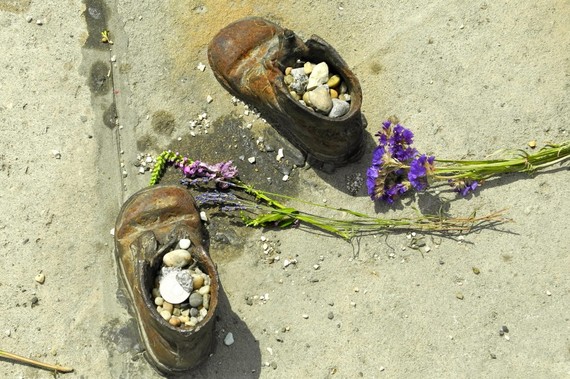It's the shoes that make me cry.
In Budapest last summer, we happened upon a protest called Eleven Emlekmu Living Memorial. 2014 was the 70th anniversary of the mass deportation of Hungary's Jews to die in concentration camps.
We asked our Hungarian guide what it meant and she replied it was controversial -- some believed the monument under construction in Freedom Square implied Hungary was also a victim of Nazi aggression during WWII while others thought Hungary was a collaborator and should acknowledge its role in sending countless Jews to their deaths.
But it was hardly controversial to those who had been quietly protesting for 75 days. Their makeshift memorial included photos, candles, letters, and stones (part of the Jewish tradition of leaving a stone when visiting a grave). There were pleas to "never forget" the 6 million Jews who were murdered in the Holocaust.
We walked to the banks of the Danube -- more shoes. These were put here to remind us that in 1944-45, Jews were told to remove their shoes and then shot and pushed into the river. As one of our guides said, "They disappeared." Only their shoes remained behind. Some of them were so tiny.
I thought about the sweetness of a child's shoe. In a photo of my mother from 1924, I am drawn to her scuffed Mary Jane shoes. I look my bronzed baby shoes sitting on a shelf in my office. My son's saddle shoes were all the rage in the '70s. I remember my grandchildren toddling in their Robeez.
As I shared in a post published on April 28, 2014, which was Holocaust Remembrance Day last year, in my sheltered life growing up in a suburb of Detroit, there was not much conversation about the Holocaust. Perhaps the late 1950s were still too soon to speak openly about such things. So I struggled to understand how people, who would have included me had my grandparents not decided to immigrate to America, were exterminated just because they were Jewish. I had nightmares about being sent to a concentration camp. It was beyond my comprehension and none of the adults in my life wanted to discuss what had happened and, more importantly, why.
I wonder if, like America in the 1950s, Eastern Europe is not yet ready for this difficult conversation. In Vienna, our young German-born guide seemed sorry about what happened but was also not able to answer some of our basic questions about current thinking in Austria regarding its role in the Holocaust. On the other hand, our Jewish guide shared that Austrians felt their suffering at the end of WWII and during the Soviet occupation was comparable to what the Jews had endured. The same held true in Prague. Our kind, grandmotherly Czech guide, whose family had hidden a Jewish daughter-in-law at great peril, told story after story of hardships and cruelty at the hands of the Russians.
Going to Terezin was painful for our guide Olga because of the Czech martyrs who had died there. Who is to say that my pain is more valid than hers? After visiting restored synagogues in all three cities, after seeing graves covered with stones, after looking at far too many lists of names of people whose date of death was 1944, it was the shoes that hit me like a punch in the gut.
It is only luck that separates me from those who perished. My mother's shoes could have become part of the Living Memorial. No bronzed baby shoes, saddle shoes, or sweet Robeez would have followed for our family.
Life is as fragile and precious as a child's shoe. And the current generation of children, in Budapest or Baltimore, need to know that such evil happened. This is the only way we have a prayer that it will not happen again.
A version of this post appeared in ChicagoNow on July 14, 2014.
I invite you to join my Facebook community and subscribe to my newsletter.


